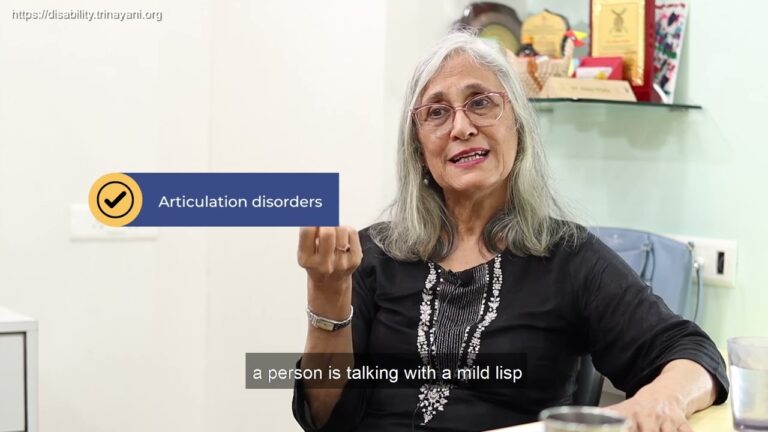Hearing Tests: A Closer look
Welcome to this insightful film on hearing evaluation providing an overview of the methods used by audiologists to diagnose hearing problems, in both adults and children. It educates viewers on the technical aspects of hearing evaluation and signifies the impact that proper hearing care can have on a person’s quality of life. We also get to know about the different types of hearing loss and how based on the type and severity of the hearing loss, audiologists recommend treatments such as hearing aids or, in some cases, cochlear implants.
Millions of people in India are affected by hearing loss, making early detection through hearing evaluations crucial for timely intervention
This film explores the different kinds of hearing evaluations and their vital role in improving lives
*
As a patient enters the clinic, the first thing what we’re going to do is, take a detailed case history.
This will help us understand or what is might be the problem.
So, we can guess what type and degree of hearing loss it is. Based on that we can decide the test batteries.
The first thing what we’re going to do is do the Otoscopic evaluation.
This will help us to find if the outer ear have any problem or not. Mainly if any wax is there, if there is any fungal infection or if there is any foreign body in the ear, we’ll be able to find it.
If any of this is there, that will affect our testing.
So if it is there, then we will send them to the ENT, clear it and then we are going to start the testing.
The first thing what you’ll do after clearing is Pure Tone Audiometry , then Immittance (audiometry) to find the middle ear pathology and based on that we’ll be able to find it.
And if we need any further evaluation, based on these two results we will do that also.
*
Can you explain the process of evaluating hearing for both children and adults?
So when a child comes to clinic with a hearing problem or without a hearing problem, the way we approach them is very different. Okay?
So initially, a child, they will not be able to respond on their own.
So when you ask them whether you can hear it or not, they will not be able to tell properly, even if they know or you don’t know.
So, there are different things that we’re going to do which is physiological, where we don’t need their response.
So we’re going to do ABR, Auditory Brainstem Response, where the baby have to sleep, they have to sleep for more than 1 hour continuously.
If they don’t sleep, then we will have to do the test, maybe 2/3 times, okay, to get the proper response.
So, once they come this ABR response is nothing but they have to sleep and we are going to get a response directly from the brainstem.
So they are not going to respond for it, we will get it without even their response.
And OAE is one more test, which is used to find if uh inner ear have any problem or not.
So with both the test together, we be able to give a proper diagnosis.
With this we’ll be able to find which type of problem this person have or the child have.
Whereas in adult, they will be able to respond on their own.
So all they have to do is, whenever they hear a sound they just have to respond, ‘yeah I can hear’ by raising the hand or pressing a button, that will be enough.
So, when we do an evaluation for an adult, we are doing different things, so mainly we want to know if they have problem, in which part of the ear, okay?
So mainly ear is divided into three: outer ear, middle ear and inner ear.
So if the problem is there in the inner ear that means it is nerve related problem and if the problem is there in the middle ear, that means it is a conductive pathology which can be solved by doing surgery or medication.
Okay, so we want to know whether it is inner ear problem or outer ear problem or middle ear problem to give a proper management.
So, if we are going to do different test batteries.
Test batteries means we are going to use more than one test.
So one test is used to find the degree and type of hearing loss and the other test called Immittance is used to find the middle ear pathology.
So, with this we’ll be able to understand whether it is nerve related problem or whether it is conductive related problem.
So conductive pathology we’ll send to uh ENT, whereas if it is nerve related problem, which is not reversible, we’re going to give them a hearing aid.
And again hearing aid will…is not the same for everyone.
So for everyone we have to program the hearing aid, based on their type and degree of loss.
There are other hearing aids “in the ear” hearing aid, “in the canal” hearing aid “completely in the canal” and “invisible in the canal” hearing aids.
So those are custom made, where we will take impression of the patient and then made it according to their size.
So we have Ramachandra Naidu who came to the department with the history of rearing problems so we are going to check for Presbycusis, which is called “old age hearing loss”.
So I have already plotted the response in the PTA, now I’m going to plot it in the audiogram.
Once Pure-tone audiometry is done, the result are plotted in a graph, that is called an Audiogram.
So, audiogram is used to find if a person have sensori-neural hearing loss, mixed hearing loss or conductive hearing loss.
So based on that we’ll be able to explain to the patient whether they have to meet a surgeon for surgery or medication or they have to go for a hearing aid and there is also an option called “cochlear implant”.
So, which can be given mainly for children.
So here uh we have to look for a type of hearing loss and degree of hearing loss.
If the degree of hearing loss is more, then hearing aid will not be beneficial for that particular patient, so they have to go for a cochlear implant.
And also for cochlear implant, they should have a profound hearing loss and also they should prove that using the hearing aid they are not getting any benefit.
So once that is done we can go for a cochlear implant.
And again there are a few government schemes which is available for them to do free cochlear implant uh and mainly the age should be lesser than 5 years.
Um greater than 5 years I don’t think any scheme is available but if you child is less than 5 years, it is possible to get free uh cochlear implantation.
Okay, so this is cochlear implant, so cochlear implant is divided into two things.
One is internal, another one is external.
So this is connected to our ear and this will be connected to our skull.
So through magnet we have internal coil also, which will be connected inside the skull through operation.
And this is a electrode array which will be inserted inside the cochlear.
So based on this, this will pick up the sound and send it though this coil, inside the internal coil and the internal coil will send the information through electrodes and this electrode array has different sessions which will stimulate the auditory nerve and these signals will be sent to the brain.
So that’s how you will understand the speech.
Resources
adult hearing assessment, audiogram, audiology, audiometry, auditory brainstem response, auditory testing, child hearing assessment, cochlear implant, conductive hearing loss, ear pathology, ENT, hearing aids, Hearing Impairment, hearing loss, immittance, OAE, otoscopic evaluation, presbycusis, pure tone audiometry, sensori-neural hearing loss, speech understanding
Dive Deeper: More on Disability
Learn about the most common inquiries surrounding disability, education, legislation, accessibility, employment and other sectors related to disability.


















